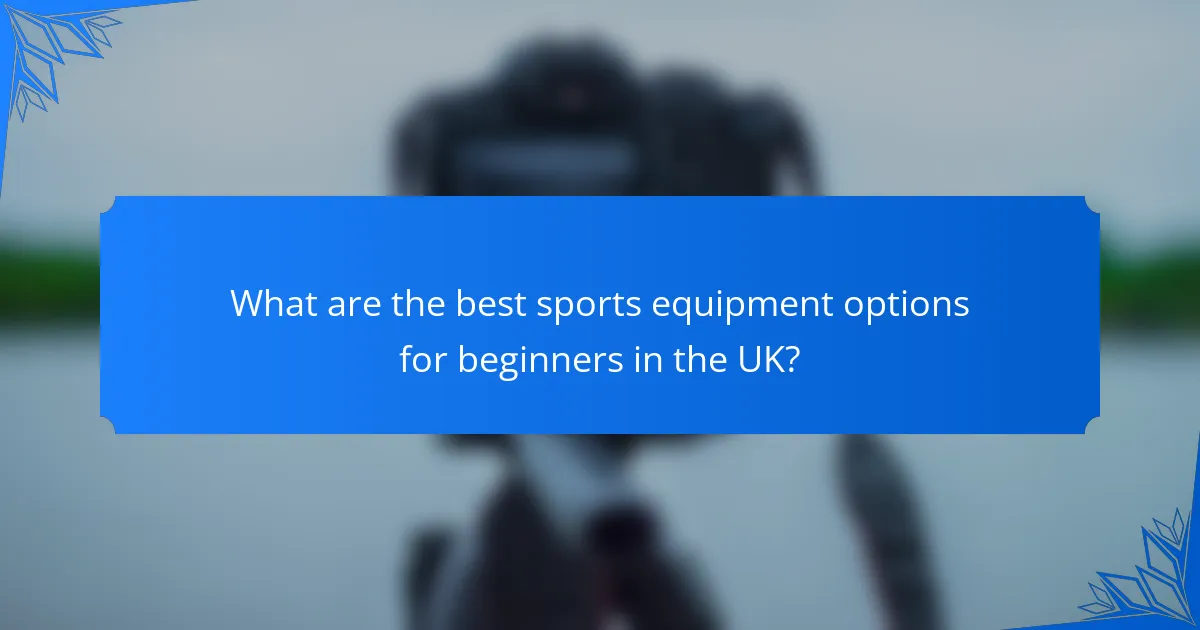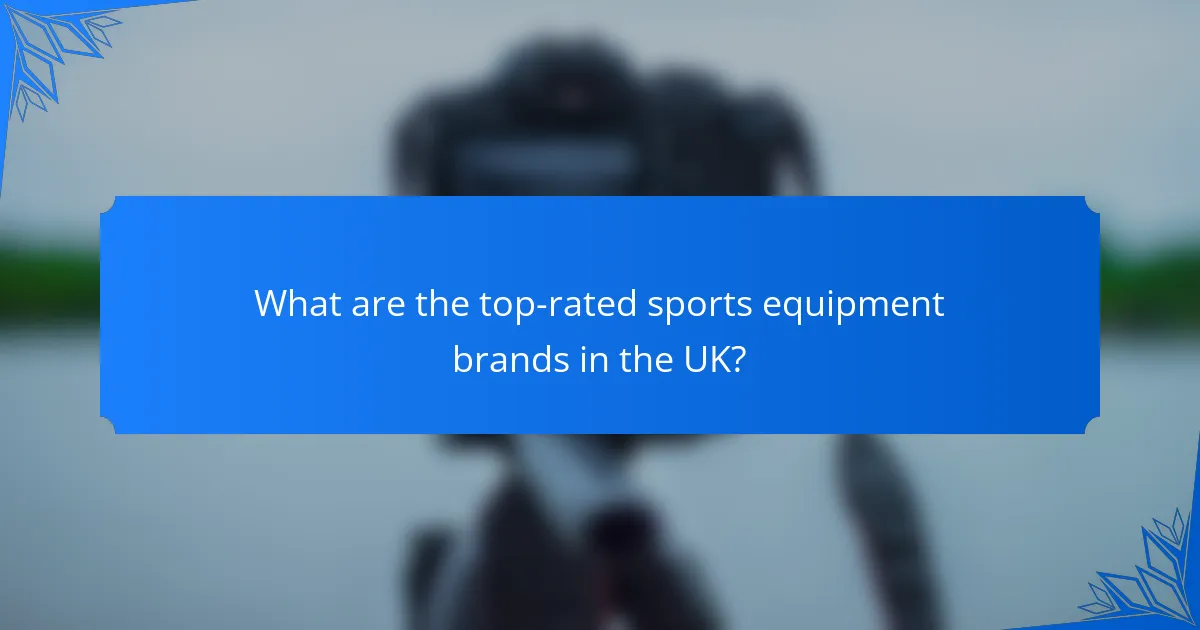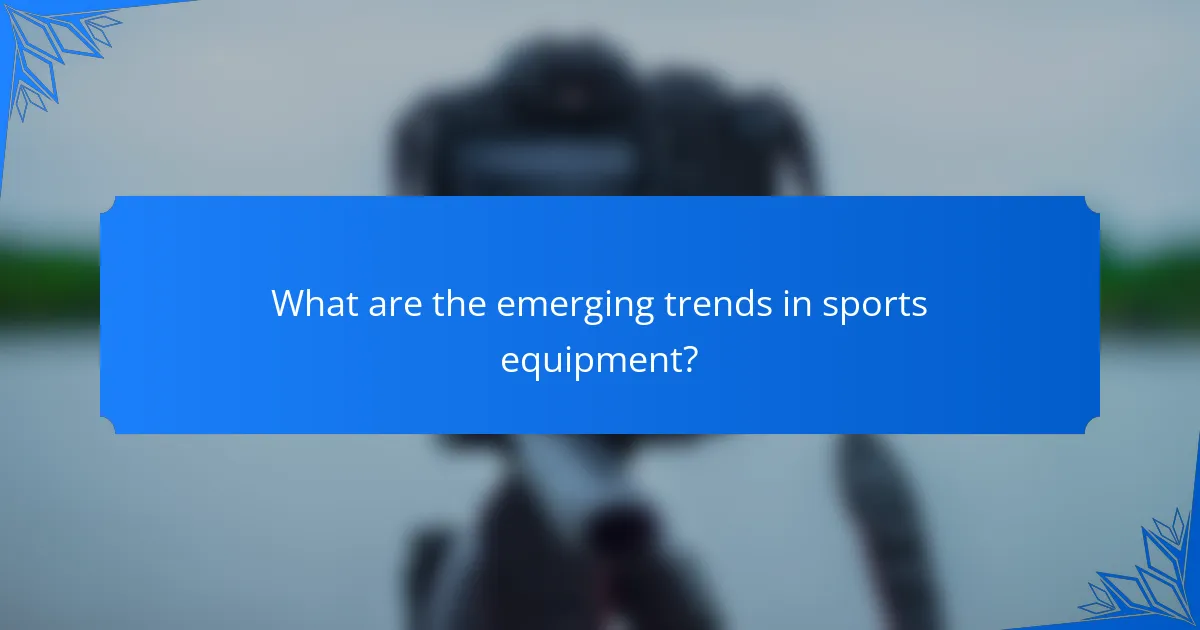Choosing the right sports equipment is essential for athletes of all skill levels, as it can significantly impact performance and enjoyment. Beginners should prioritize affordability and quality, while understanding that skill level dictates the necessary features and specifications. Additionally, the relationship between quality and price is important, with higher quality often commanding a higher price, though some brands provide great value without compromising performance.

What are the best sports equipment options for beginners in the UK?
For beginners in the UK, the best sports equipment options focus on affordability, quality, and ease of use. Selecting the right gear can enhance performance and enjoyment while minimizing the risk of injury.
Beginner-friendly brands
Several brands are known for producing beginner-friendly sports equipment that balances quality and price. Brands like Decathlon, Wilson, and Adidas offer a range of products designed specifically for newcomers. These brands often provide user-friendly features and solid warranties, making them ideal for those just starting out.
When choosing a brand, consider customer reviews and product ratings to ensure the equipment meets your needs. Look for brands that offer good customer support and easy return policies, which can be helpful if you need to exchange or return items.
Essential equipment types
The essential equipment types for beginners depend on the sport but generally include items like footwear, protective gear, and basic training tools. For example, runners need quality shoes, while cyclists should invest in a reliable helmet and a comfortable bike. In team sports, like football or basketball, a good ball and appropriate footwear are crucial.
It’s wise to start with the basics and gradually expand your gear as you improve. Avoid overspending on advanced equipment until you are sure of your commitment to the sport.
Price ranges for beginners
Price ranges for beginner sports equipment in the UK can vary widely based on the type of sport and brand. Generally, you can expect to spend anywhere from £20 to £100 for basic gear. For instance, a decent pair of running shoes might cost around £40 to £80, while a beginner’s bicycle could range from £150 to £300.
When budgeting, consider looking for sales or second-hand options to save money. Many retailers offer discounts for first-time buyers or seasonal sales, which can help you get quality equipment without breaking the bank.

How does skill level affect sports equipment choices?
Skill level significantly influences the type of sports equipment an athlete should choose, as it determines the features and quality needed for optimal performance. Novice, intermediate, and advanced athletes have different requirements that align with their experience and goals.
Equipment for novice athletes
Novice athletes typically require basic equipment that is user-friendly and affordable. This gear should provide essential functionality without overwhelming features that may complicate the learning process.
For example, beginner runners might opt for cushioned shoes that offer comfort and support, while novice cyclists may choose entry-level bikes that prioritize stability over advanced technology. Generally, spending in the low hundreds of USD is common for novice gear.
Intermediate athlete requirements
Intermediate athletes often seek equipment that enhances performance while still being accessible. This group typically benefits from gear that incorporates improved materials and technology, offering a balance between quality and price.
For instance, an intermediate tennis player might invest in a mid-range racket that provides better control and spin compared to a novice model. Prices for intermediate equipment can range from a few hundred to around a thousand USD, depending on the sport.
Advanced sports gear features
Advanced athletes require high-quality equipment that maximizes performance and meets specific competitive standards. This gear often includes advanced technology, lightweight materials, and customizable features tailored to the athlete’s unique style.
For example, elite swimmers might use specialized suits designed for hydrodynamics, while professional golfers may opt for custom-fitted clubs. Prices for advanced sports gear can vary widely, often exceeding a thousand USD, reflecting the investment in performance enhancement.

What is the relationship between quality and price in sports equipment?
The relationship between quality and price in sports equipment is generally direct; higher quality often comes with a higher price tag. However, this isn’t a strict rule, as some brands offer excellent quality at competitive prices, while others may charge more for branding rather than performance.
High-quality brands and their pricing
High-quality sports equipment brands, such as Nike, Adidas, and Under Armour, typically price their products in the mid to high range, often starting from around $50 and going up to several hundred dollars. These brands invest in advanced materials and technology, which enhances performance and durability.
For example, a premium running shoe from a well-known brand may cost between $100 and $250, reflecting its superior cushioning and support features. Consumers often find that these investments lead to better performance and longevity.
Budget-friendly options
Budget-friendly sports equipment can be found from brands like Decathlon, Champion, and various store brands, with prices often ranging from $10 to $50. These options are suitable for beginners or casual users who may not need the advanced features of high-end products.
While these budget items may lack some high-tech features, they can still provide decent performance for recreational use. For instance, a basic pair of running shoes might cost around $30 and serve well for occasional joggers.
Value for money analysis
When analyzing value for money in sports equipment, consider both the upfront cost and the long-term benefits. Higher-priced items may offer better durability and performance, potentially saving money over time due to less frequent replacements.
It’s wise to assess your skill level and frequency of use. For serious athletes, investing in high-quality gear can enhance performance and comfort, while casual users might find satisfactory performance in budget options. Always read reviews and compare features to ensure you are getting the best value for your investment.

What are the top-rated sports equipment brands in the UK?
In the UK, top-rated sports equipment brands include names like Adidas, Nike, and Under Armour, known for their quality and performance. These brands cater to a variety of sports and are recognized for their innovation and reliability.
Popular brands for various sports
Different sports have their preferred brands based on performance and athlete endorsements. For example, Adidas and Nike dominate in football and running gear, while Wilson and Head are well-regarded in tennis. In cycling, brands like Specialized and Trek are popular among enthusiasts.
When selecting equipment, consider the sport-specific needs. For instance, basketball players often prefer brands like Jordan for footwear, while swimmers might choose Speedo for swimwear. Researching the best options for your sport can enhance your performance significantly.
Brand reputation and quality
Brand reputation in sports equipment is often tied to quality and durability. Leading brands invest heavily in research and development to ensure their products meet high standards. For instance, many athletes trust brands like Mizuno for running shoes due to their reputation for comfort and support.
Quality can often be assessed through customer reviews and professional endorsements. Look for brands that offer warranties or satisfaction guarantees, as these can indicate confidence in their products. Avoid brands with consistently negative feedback, as this may reflect poor quality or performance issues.

How to choose the right sports equipment for your needs?
Choosing the right sports equipment involves assessing your specific needs, including your skill level, the quality of the gear, and your budget. Understanding these factors helps ensure you select equipment that enhances your performance and enjoyment of the sport.
Factors to consider
When selecting sports equipment, consider the type of sport, your personal preferences, and the conditions in which you will be using the gear. Quality is crucial; investing in durable, well-reviewed products can save money in the long run. Additionally, price varies widely, so set a budget that reflects both your needs and the level of quality you desire.
Evaluate the features that matter most for your sport. For example, if you’re buying running shoes, look for cushioning, support, and fit. If you’re choosing a tennis racket, consider weight, grip size, and string tension. Prioritize features that align with your performance goals.
Skill level assessment
Your skill level significantly influences the type of equipment you should choose. Beginners may benefit from more forgiving gear that helps develop skills, while advanced athletes might prefer specialized equipment that enhances performance. For instance, a novice golfer might choose a set of oversized clubs for better control, whereas an experienced player would opt for clubs tailored to their swing style.
To assess your skill level, reflect on your experience, comfort with the sport, and specific goals. If you’re unsure, consult with coaches or experienced players who can provide insights. This assessment will guide you in selecting equipment that matches your abilities and helps you progress effectively.

What are the emerging trends in sports equipment?
Emerging trends in sports equipment focus on enhanced performance, sustainability, and user customization. Innovations in materials and technology are reshaping how athletes train and compete, making equipment more efficient and tailored to individual needs.
Innovative materials and technology
Innovative materials, such as carbon fiber and advanced polymers, are revolutionizing sports equipment by providing strength while reducing weight. This allows athletes to perform better without the burden of heavy gear. For instance, lightweight tennis rackets and running shoes can significantly improve speed and agility.
Technology integration, such as smart sensors and data analytics, is becoming common in sports gear. These features help athletes track performance metrics, monitor health, and refine techniques. For example, smart basketballs can provide feedback on shooting accuracy, while fitness trackers can analyze running form.
When selecting equipment, consider the balance between cutting-edge features and personal comfort. High-tech gear may come at a premium price, so evaluate whether the benefits align with your skill level and goals. Investing in quality materials can enhance durability, but ensure they fit your specific needs and budget constraints.

